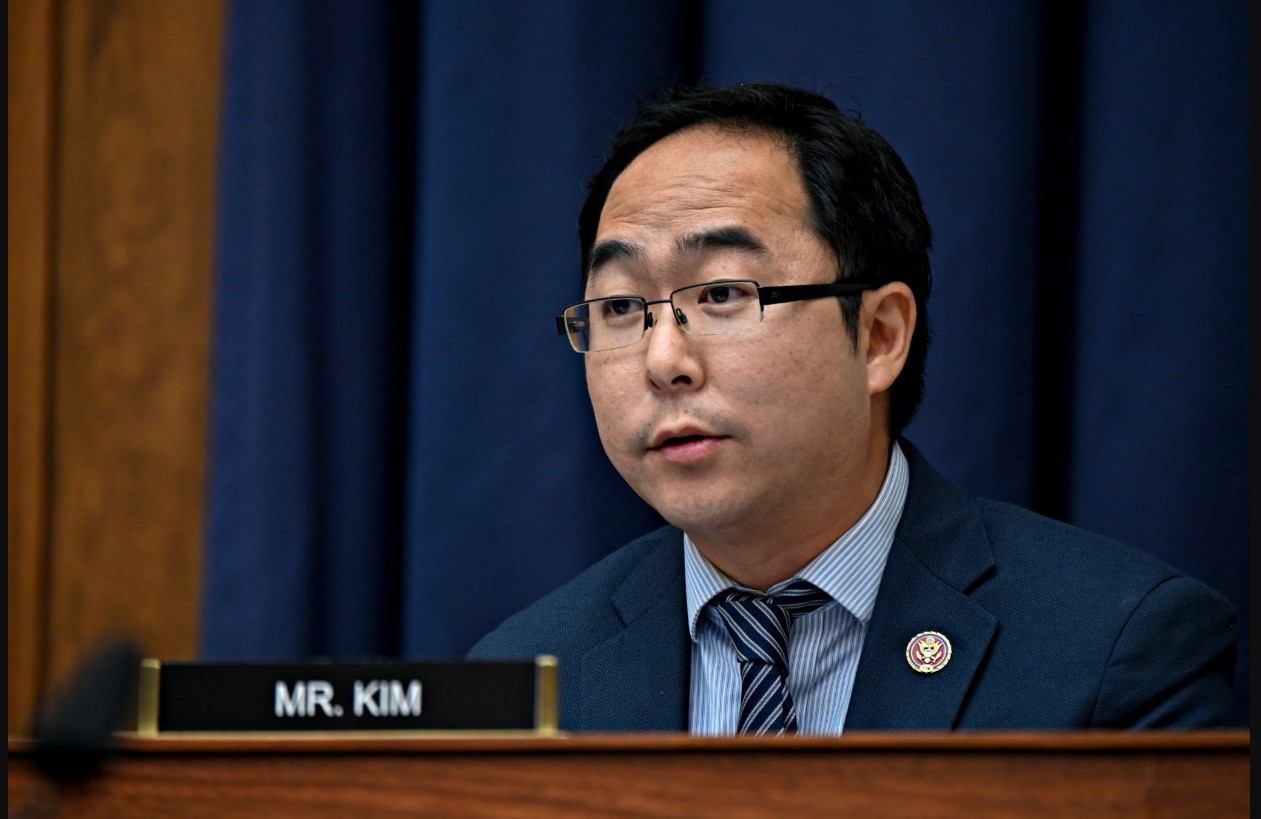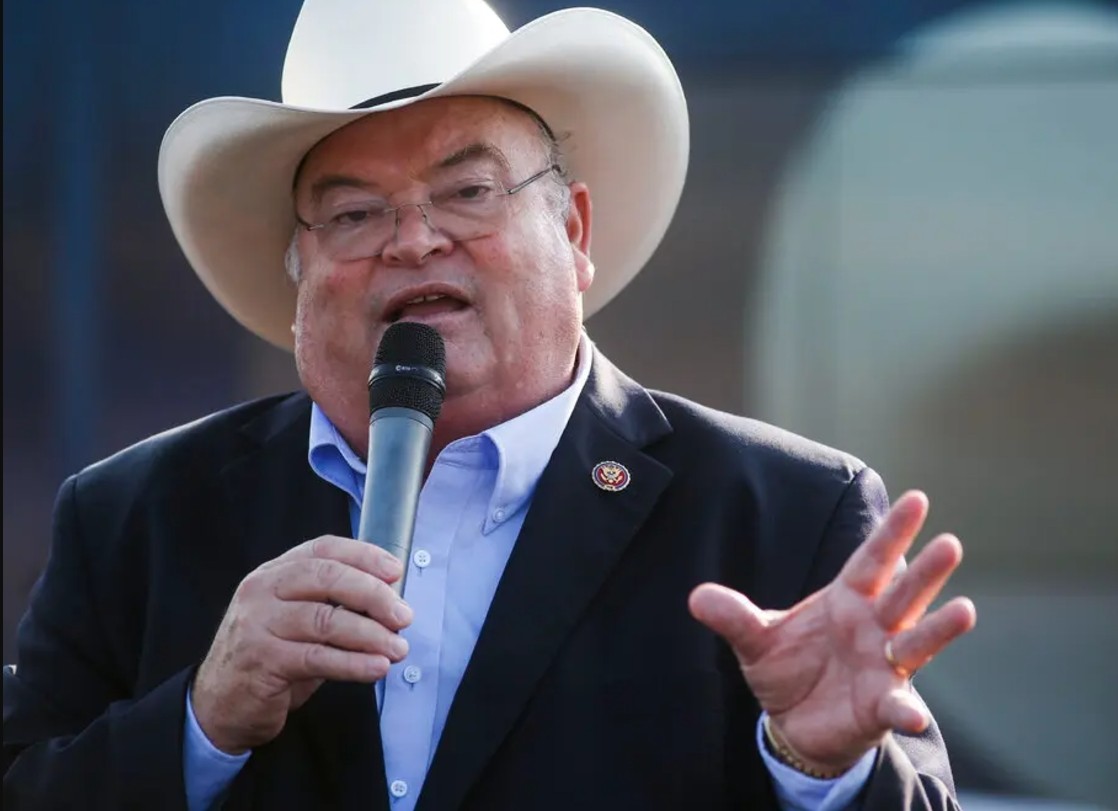Full List of the Governors in the US: Biography, Profile, Power, Role, Personal Life and Family
 |
| NEW YORK Gov. Andrew Cuomo/ Photo: (DAVID DEE DELGADO/GETTY IMAGES) |
Who is Governor and overview of the title?
Ballotpedia defines, in the United States, the title governor refers to the chief executive of each state. The governor is not directly subordinate to the federal authorities but is the political and ceremonial head of the state. The governor may also assume additional roles, such as the commander-in-chief of the National Guard when the role is not federalized. The governor may also have the ability to commute or pardon a criminal sentence.
In all states, the governor is directly elected and, in most cases, has considerable practical powers. Notable exceptions with weak governorships include the office of the governor in Texas, though this may be moderated by the state legislature and, in some cases, by other elected executive officials. Governors can veto state bills. The specific duties and powers vary widely between states.
Governors carry out their management and leadership responsibilities and objectives with the support and assistance of department and agency heads, many of whom they are empowered to appoint. A majority of governors have the authority to appoint state court judges as well, in most cases from a list of names submitted by a nominations committee.
Although governors have many roles and responsibilities in common, the scope of gubernatorial power varies from state to state in accordance with state constitutions, legislation, and tradition, and governors often are ranked by political historians and other observers of state politics according to the number and extent of their powers. Ranking factors may include the following.
Qualifications and tenure of U.S Governors
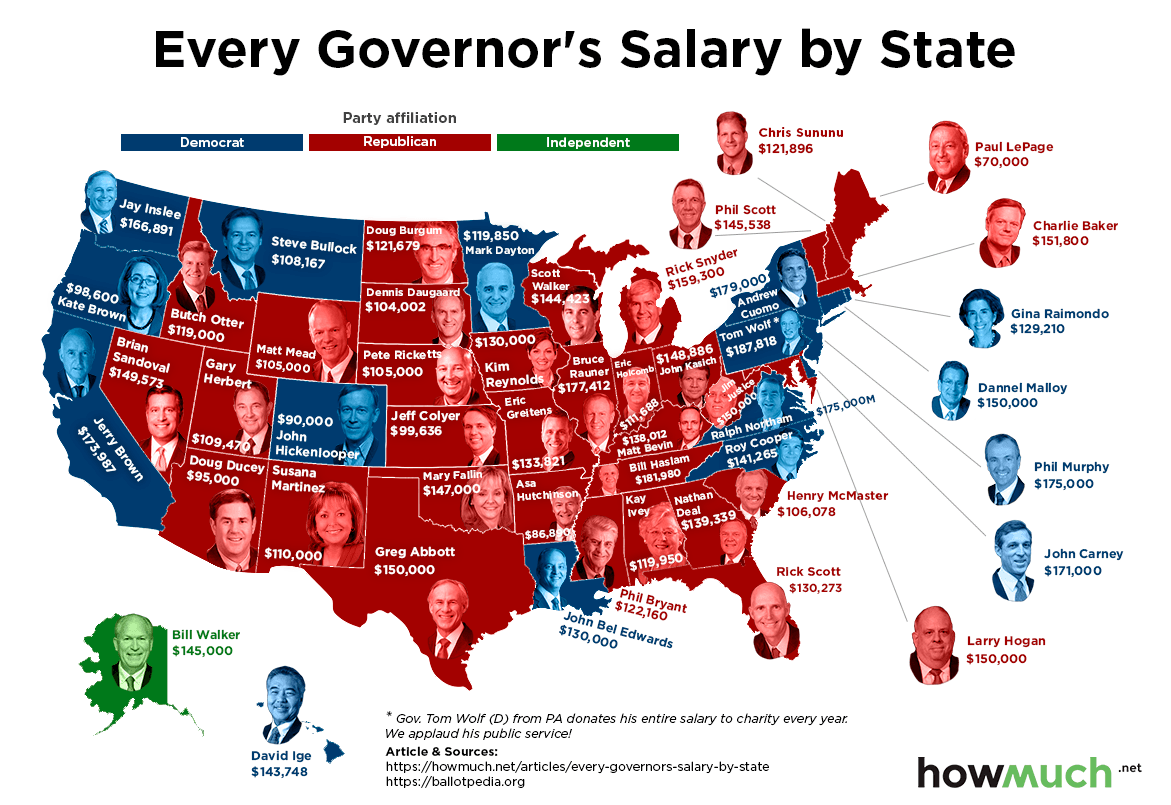 |
| Mapping Governor's Salary in Every State. Photo: Howmuch.net. |
Appointment sovereignty
Although not necessarily a ranking factor, the power to issue executive orders and take emergency actions is a significant gubernatorial responsibility that varies from state to state, according to National Governors Association.
Qualifications
States, commonwealths, and territories vary with respect to minimum age, U.S. citizenship, and state residency requirements for gubernatorial candidates and office holders. The minimum age requirement for governors ranges from no formal provision to age 35. The requirement of U.S. citizenship for gubernatorial candidates ranges from no formal provision to 20 years. State residency requirements range from no formal provision to 7 years.
Terms
Gubernatorial terms are four years in every state, commonwealth, and territory but New Hampshire and Vermont, which have two year terms. All governors with the exception of Virginia’s may succeed themselves, although they may be limited to a specific number of consecutive or total terms.
For state by state information on gubernatorial qualifications, see “The Governors: Qualifications for Office“(Table 4.2, The Book of the States 2019, source: The Council of State Governments).
For state by state information on gubernatorial term limits, see NGA’s Current Governors by State, Party, and Terms in Office, and “Constitutional and Statutory Provisions for Number of Consecutive Terms of Elected State Officials” (Table 4.9, The Book of the States 2019, source: The Council of State Governments).
Vacancies/Succession
In the event of a vacancy in office, the lieutenant governor is the designated official who succeeds the governor in 49 states and territories (in two of which—Tennessee and West Virginia—the president/speaker of the Senate and lieutenant governor are one and the same). In the remaining 5 states and the Commonwealth of Puerto Rico, officials designated to succeed the governor include the secretary of state and leader of the senate.
For state by state information on succession, see “The Governors” (Table 4.1, The Book of the States 2019, source: The Council of State Governments). For more information on lieutenant governors and other executive branch officials, see the Appointment Power section below.
Impeachment
All states except Oregon provide for the impeachment of governors. As in the case of the federal government, the impeachment process starts with the lower body of the legislature and the trial is conducted by the upper body in every state but Alaska—where the process is reversed, and Nebraska, which has a unicameral legislature charged with the full impeachment process. In most cases, impeachment requires a majority of members, while conviction generally requires a two-thirds or other special majority.
Should a governor be impeached, the lieutenant governor serves as acting governor in the vast majority of states. For state by state information on impeachment, see “Impeachment Provisions in the States” (Table 4.8, The Book of the States 2019, source: The Council of State Governments). For more information on lieutenant governors, see the Appointment Power section below.
Legislative Role
Governors play two broad roles in relation to state legislatures. First, they may be empowered to call special legislative sessions, provided in most cases that the purpose and agenda for the sessions are set in advance.
| Second, and more familiarly, governors coordinate and work with state legislatures in: approval of state budgets and appropriations; enactment of state legislation; confirmation of executive and judicial appointments; and legislative oversight of executive branch functions |
Approval Of State Budgets And Appropriations
Governors develop and submit annual or biennial budgets for review and approval by the legislature. In a number of states, commonwealths, and territories, governors also have “reduction”—most often referred to as “line-item”—veto power that can be used for the removal of appropriations to which they object, according to National Governors Association.
These tools allow governors and their budget staff to play a strong role in establishing priorities for the use of state resources. For state by state information on gubernatorial budget making and line-item veto power, see “The Governors: Powers” (Table 4.4, The Book of the States 2019, source: The Council of State Governments).
Enactment Of Legislation
Governors often use State of the State messages to outline their legislative platforms, and many governors prepare specific legislative proposals to be introduced on their behalf. In addition, state departments and agencies may pursue legislative initiatives with gubernatorial approval. Executive branch officials often are called to testify on legislative proposals, and governors and other executive branch leaders will seek to mobilize public opinion and interest groups in favor of or opposition to specific legislative proposals. Governors may use their role as party leaders to encourage support for legislative initiatives, and along with department heads and staff may seek to influence the progress of legislation through regular meetings with legislators and legislative officials.
Veto Power
All 50 state governors have the power to veto whole legislative measures. In a large majority of states a bill will become law unless it is vetoed by the governor within a specified number of days, which vary among states. In a smaller number of states, bills will die (pocket veto) unless they are formally signed by the governor, also within a specified number of days. Other types of vetoes available to the governors of some states include “line-item” (by which a governor can strike a general item from a piece of legislation), “reduction” (by which a governor can delete a budget item), and “amendatory” (by which a governor can revise legislation). Legislatures may override vetoes, usually by a supermajority vote.
For state by state information about veto powers, see “The Governors: Powers” (Table 4.4, The Book of the States 2019, source: The Council of State Governments) and “Enacting Legislation: Veto, Veto Override and Effective Date” (Table 3.16, The Book of the States 2019, source: The Council of State Governments).
Confirmation Of Appointments
Many gubernatorial appointments require legislative confirmation. For additional information, see the Appointment Power section below as well as “Selected State Administrative Officials: Methods of Selection” (Table 4.10, The Book of the States 2019, source: The Council of State Governments).
Legislative Oversight
Governors interact with their legislatures to help ensure that their priorities, goals, and accomplishments are accurately presented and positively received during oversight hearings and other legislative activities that address and evaluate executive branch implementation of legislatively mandated programs and services.
List of Governors of the American States:
(Party: Red - Republican// Blue - Democratic)
- Governor of Alabama - Kay Ivey
- Governor of Alaska - Mike Dunleavy
- Governor of American Samoa - Lolo Matalasi Moliga
- Governor of Arizona - Doug Ducey
- Governor of Arkansas - Asa Hutchinson
- Governor of California - Gavin Newsom
- Governor of Colorado - Jared Polis
- Governor of Connecticut - Ned Lamont
- Governor of Delaware - John C. Carney Jr.
- Governor of Florida - Ron DeSantis
- Governor of Georgia - Brian Kemp
- Governor of Guam - Lou Leon Guerrero
- Governor of Hawaii - David Ige
- Governor of Idaho - Brad Little
- Governor of Illinois - J.B. Pritzker
- Governor of Indiana - Eric Holcomb
- Governor of Iowa - Kim Reynolds
- Governor of Kansas - Laura Kelly
- Governor of Kentucky - Andy Beshear
- Governor of Louisiana - John Bel Edwards
- Governor of Maine - Janet T. Mills
- Governor of Maryland - Larry Hogan
- Governor of Massachusetts - Charles D. Baker
- Governor of Michigan - Gretchen Whitmer
- Governor of Minnesota - Tim Walz
- Governor of Mississippi - Tate Reeves
- Governor of Missouri - Mike Parson
- Governor of Montana - Steve Bullock
- Governor of Nebraska - Pete Ricketts
- Governor of Nevada - Steve Sisolak
- Governor of New Hampshire -Chris Sununu
- Governor of New Jersey - Phil Murphy
- Governor of New Mexico - Michelle Lujan Grisham
- Governor of New York - Andrew Cuomo
- Governor of North Carolina -Roy Cooper
- Governor of North Dakota -Doug Burgum
- Governor of Ohio - Richard Michael DeWine
- Governor of Oklahoma - Kevin Stitt
- Governor of Oregon - Kate Brown
- Governor of Pennsylvania -Tom Wolf
- Governor of Puerto Rico - Wanda Vázquez Garced (New Progressive)
- Governor of Rhode Island - Gina Raimondo
- Governor of South Carolina - Henry McMaster
- Governor of South Dakota - Kristi L. Noem
- Governor of Tennessee - Bill Lee
- Governor of Texas - Greg Abbott
- Governor of the Northern Mariana Islands - Ralph Torres
- Governor of the U.S. Virgin Islands - Albert Bryan
- Governor of Utah -Gary Herbert
- Governor of Vermont - Phil Scott
- Governor of Virginia -Ralph Northam
- Governor of Washington - Jay Inslee
- Governor of West Virginia - Jim Justice
- Governor of Wisconsin - Tony Evers
- Governor of Wyoming - Mark Gordon
 Who is Tony Evers - the Current Governor of Wisconsin Who is Tony Evers - the Current Governor of Wisconsin Anthony Steven Evers, the 46th governor of Wisconsin since January 7, 2019, is often regarded as the hero who dedicated his life to fighting for ... |
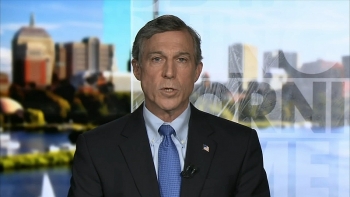 Who is John Carney - the Current Governor of Delaware? Who is John Carney - the Current Governor of Delaware? John Carney (Democratic Party) is the Current Governor of Delaware. He assumed office on January 17, 2017 and his current term ends on January 19, ... |
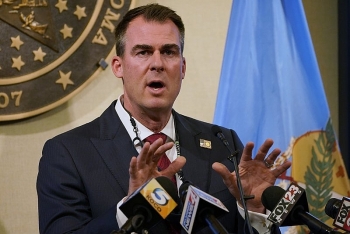 Who is Kevin Stitt - the Current Governor of Oklahoma Who is Kevin Stitt - the Current Governor of Oklahoma John Kevin Stitt is the current governor of Oklahoma since January 2019 and the former chairman and CEO of Gateway Mortgage Group. If you want ... |
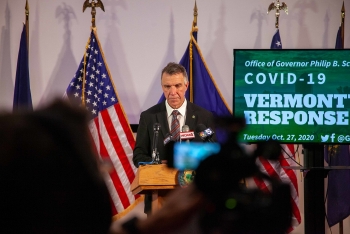 Who is Philip B. Scott - the Current Governor of Vermont Who is Philip B. Scott - the Current Governor of Vermont Philip B. Scott's biography: Who is Philip B. Scott, the Current Governor of Vermont- one of the big states in the US? If you once ... |

